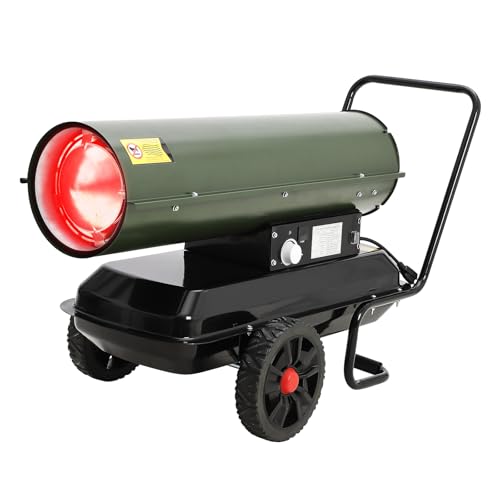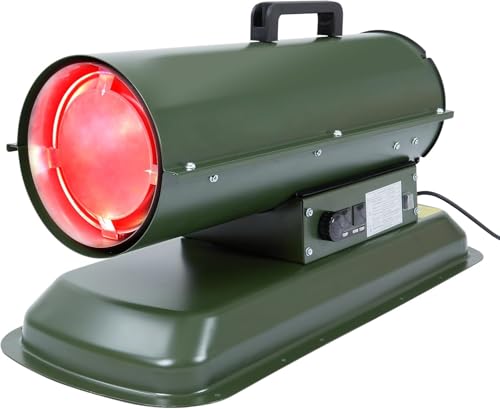Diesel torpedo heaters provide powerful, portable heat for garages, workshops, and jobsite spaces. This guide compares five relevant models available on Amazon, focusing on indoor suitability, fuel compatibility, output, and runtime. Below is a quick comparison table to help you scan key specs.
| Product | BTU / Output | Fuel Options | Coverage / Runtime Notes |
|---|---|---|---|
| Mr. Heater 80,000 BTU Forced Air | 80,000 BTU | Kerosene, Filtered Diesel #1/#2, Fuel Oil, Jet A | Up To 2,000 sq ft; Built-In Thermostat |
| Towallmark 125,000 BTU Forced Air | 125,000 BTU | Diesel, Kerosene, Home Heating Oil, Jet Fuel | Up To 3,125 sq ft; 26L Tank, Up To 8 Hours |
| PioneerWorks 80,000 BTU Forced Air | 80,000 BTU | Diesel, Kerosene, Home Heating Oil, Jet Fuel | Up To 2,000 sq ft; 4.76 Gal Tank, ~9.5 Hours |
| ProTemp 140,000 BTU Torpedo Heater | 140,000 BTU | Forced Air Design (industrial use) | High CFM Up To 12,000; Designed For Warehouses |
| SUNFIRE Radiant Heater SF120 | 120,000 BTU (Radiant) | Diesel / Kerosene | Radiant Heat, Up To 2,800 sq ft; Long Run Time |
Content Navigation
- Mr. Heater 80,000 BTU Forced Air Kerosene Heater Black
- Towallmark 125,000 BTU Forced Air Diesel Heater
- PioneerWorks 80,000 BTU Forced Air Diesel Heater
- ProTemp 140,000 BTU Kerosene/Diesel Forced Air Torpedo Heater
- SUNFIRE Radiant Heater – 120,000 BTUs Diesel/Kerosene Portable (SF120)
- Buying Guide: Choosing A Diesel Torpedo Heater For Indoor Use
- Fuel Type And Compatibility
- Heater Type: Forced Air vs Radiant
- BTU Output And Space Coverage
- Ventilation, Exhaust, And Indoor Safety
- Runtime, Tank Size, And Fuel Consumption
- Airflow And Distribution
- Noise, Odor, And Indoor Comfort
- Portability, Footprint, And Installation
- Controls, Thermostats, And Diagnostics
- Maintenance And Durability
- Regulatory And Manufacturer Guidance
- Comparison Perspectives
Mr. Heater 80,000 BTU Forced Air Kerosene Heater Black

Fuel Compatibility: Multi-fuel forced air heater compatible with kerosene, filtered diesel #1 and #2, fuel oil #1 and #2, and Jet A. The manufacturer lists multiple fuel options, which provides flexibility in supply and cost.
Heating Capacity: Rated at 80,000 BTU and listed to heat up to 2,000 sq ft. Built-in thermostat helps maintain target temperatures without constant manual adjustments.
Indoor Considerations: As a forced air torpedo heater, it circulates air and requires attention to ventilation, clearance, and fuel handling. The unit includes LED troubleshooting diagnostics to assist with maintenance and fault identification.
Towallmark 125,000 BTU Forced Air Diesel Heater

Call 888-896-7031 for Free Local HVAC Quotes – Compare and Save Today!
High Output: Provides up to 125,000 BTU, listed to heat spaces up to 3,125 sq ft. The larger output is aimed at bigger workshops, garages, and jobsite structures.
Fuel And Tank: Supports kerosene, diesel, home heating oil, and jet fuel (explicit warning not to use gasoline). The unit has a 26L (about 6.87 gal) tank and is described as running up to 8 hours on a full tank.
Portability & Dimensions: With dimensions of 35.2 x 21.5 x 26.4 inches and weight around 53.8 lb, this model balances power with transportability. Forced air design means ventilation and exhaust management must be planned for indoor use.
PioneerWorks 80,000 BTU Forced Air Diesel Heater

Fuel Options: Listed to use kerosene, diesel, home heating oil, and jet fuel (warning not to use gasoline). This multi-fuel flexibility is helpful when fuel type availability varies.
Runtime & Capacity: The fuel tank holds 4.76 gallons and the listing indicates up to 9.5 hours runtime, depending on burn rate and settings. Rated at 80,000 BTU to cover about 2,000 sq ft.
Call 888-896-7031 for Free Local HVAC Quotes – Compare and Save Today!
Application Notes: This compact model (31.49 x 12.60 x 16.93 inches, 31.96 lb) suits smaller shops and garages where a balance of output and maneuverability is needed. Forced air operation requires following manufacturer ventilation and clearance instructions.
ProTemp 140,000 BTU Kerosene/Diesel Forced Air Torpedo Heater

Airflow & Design: Features matched direct drive motors and blades designed for high airflow, with ratings up to 12,000 CFM. High CFM output moves heated air across larger interior spaces effectively.
Durability & Efficiency: Listed features include powder coated steel guards for corrosion resistance and an energy-efficient design that reportedly draws as little as 1.6 amps for electrical components.
Use Case: With 140,000 BTU output, the ProTemp model targets warehouses, construction sites, and larger workshops. As a forced air torpedo heater, indoor implementations require attention to exhaust routing and ventilation practices recommended by the manufacturer.
SUNFIRE Radiant Heater – 120,000 BTUs Diesel/Kerosene Portable (SF120)

Radiant vs Forced Air: Unlike torpedo forced air units, the SUNFIRE is a radiant heater designed to burn ~99% of fuel more completely to minimize smell and fumes. Radiant heat warms surfaces and people directly and is less affected by wind.
Runtime And Capacity: The SF120 lists up to 16 hours runtime from a 14-gallon tank at listed flow rates. Coverage is claimed up to 2,800 sq ft, with a quiet and low-odor operation noted for indoor workspaces.
Indoor Considerations: Radiant systems reduce airborne circulation of combustion byproducts compared to forced air, but any indoor combustion heater still requires proper ventilation and adherence to safety clearances and CO detection.
Buying Guide: Choosing A Diesel Torpedo Heater For Indoor Use
Fuel Type And Compatibility
Diesel, Kerosene, And Home Heating Oil: Many units support multiple fuels. Check the manufacturer’s list and warnings—do not use gasoline. Filtered diesel and specified fuel grades help reduce soot and odor.
Heater Type: Forced Air vs Radiant
Forced Air (Torpedo) Heaters: Provide rapid room air circulation and quick temperature rise. They can distribute heat evenly but may move combustion byproducts through space. Require attention to exhaust routing, ventilation, and clearance.
Radiant Heaters: Heat surfaces and occupants directly, typically quieter and less affected by drafts. Radiant units may produce fewer odors if designed for high combustion efficiency, but still require ventilation and CO monitoring.
BTU Output And Space Coverage
Match Output To Space: Estimate the cubic footage of the area and select a unit with sufficient BTU output. Higher BTU ratings cover larger spaces but increase ventilation and fuel needs.
Ventilation, Exhaust, And Indoor Safety
Ventilation Required: Indoor combustion heaters need proper ventilation to control CO and combustion byproducts. Some torpedo units are intended for well-ventilated or semi-enclosed spaces only; verify manufacturer indoor-use guidance.
Carbon Monoxide Detection: Always use functioning CO detectors in spaces where combustion heaters operate. Maintain clearance from combustible materials and follow listed safety distances.
Runtime, Tank Size, And Fuel Consumption
Runtime Tradeoffs: Larger tanks provide longer runtimes but increase weight and footprint. Runtime depends on burn setting and ambient conditions. Look for listed gallons and estimated hours to match your operational needs.
Airflow And Distribution
CFM Matters: For larger workshops, higher CFM supports faster and more uniform heat distribution. Units like those specifying matched motors and high CFM are suited to larger open interiors.
Noise, Odor, And Indoor Comfort
Noise Levels: Forced air units can be louder due to fans; radiant heaters are typically quieter. If noise matters, prioritize models marketed for quiet operation or radiant technology.
Odor And Fume Control: High-efficiency combustion and proper fuel quality reduce odors. Radiant units designed for near-complete fuel burn can lessen smell and visible fumes indoors.
Portability, Footprint, And Installation
Weight And Size: Consider transport and storage. Taller, heavier models deliver more BTU but may be harder to move between jobsites.
Installation Needs: Most torpedo heaters are plug-and-play but require safe placement and possibly exhaust routing. Some vehicle or enclosed-space heaters (e.g., diesel air heaters) may require more complex installation.
Controls, Thermostats, And Diagnostics
Built-In Thermostats And Diagnostics: Integrated thermostats and LED diagnostics help maintain temperature and troubleshoot faults without additional equipment.
Remote Control And App Features: Some diesel air heaters include remote or Bluetooth control for convenience when preheating or fine-tuning indoor comfort.
Maintenance And Durability
Service Access: Check for accessible filters, pump components, and fan assemblies for routine cleaning. Powder-coated guards and corrosion-resistant finishes extend service life in humid or dusty environments.
Regulatory And Manufacturer Guidance
Follow Manufacturer Instructions: Always consult the product manual for approved indoor applications, clearance distances, and ventilation requirements. Local codes may limit indoor combustion heater use—confirm compliance with regulations.
Comparison Perspectives
- Small Garage / Workshop: 80,000 BTU multi-fuel units (Mr. Heater, PioneerWorks) balance heat and portability.
- Large Shop / Warehouse: Higher-output forced air models (ProTemp 140k, Towallmark 125k) deliver greater coverage and airflow but increase ventilation demands.
- Low-Odor Indoor Use: Radiant units (SUNFIRE SF120) are designed to minimize smell and run longer per fill; they are often preferred where reduced fumes and quieter operation matter.
- Continuous/Remote Control Needs: Diesel air heaters with electronic controls and remote/app features suit vehicle or enclosed-space preheating, but check installation requirements for indoor stationary use.
Final Notes On Safety: Regardless of model, combustion-based heaters used indoors require strict adherence to ventilation, clearance, and CO monitoring. Verify each product’s listed indoor suitability and follow all manufacturer safety instructions.
Tips for Getting the Best HVAC Prices
- Prioritize Quality Over Cost
The most critical factor in any HVAC project is the quality of the installation. Don’t compromise on contractor expertise just to save money. - Check for Rebates
Always research current rebates and incentives — they can significantly reduce your overall cost. - Compare Multiple Quotes
Request at least three estimates before making your choice. You can click here to get three free quotes from local professionals. These quotes include available rebates and tax credits and automatically exclude unqualified contractors. - Negotiate Smartly
Once you've chosen a contractor, use the proven strategies from our guide — How Homeowners Can Negotiate with HVAC Dealers — to get the best possible final price.
